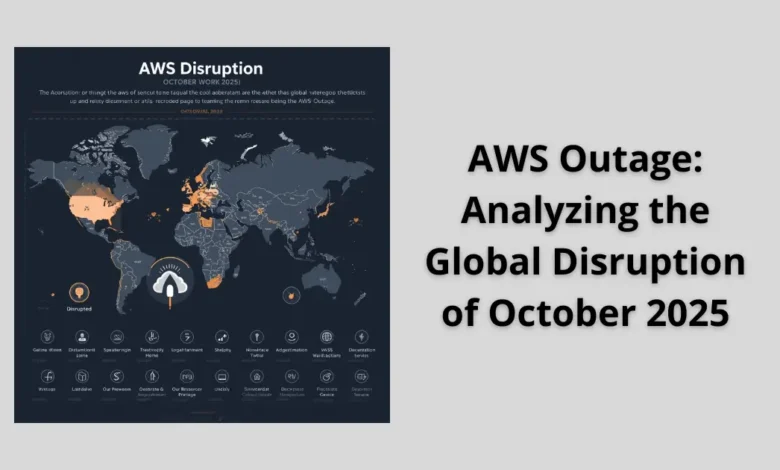AWS Outage: Analyzing the Global Disruption of October 2025

AWS Outage disrupted thousands of global services in October 2025, highlighting the critical importance of cloud resilience and infrastructure diversification.
AWS Outage has become a central topic in tech discussions following the massive service disruption on October 20, 2025. This article provides a comprehensive analysis of the incident, its impact, and lessons for businesses and cloud-dependent services.
table of contents
Understanding the October 2025 AWS Outage
The AWS Outage that occurred on October 20, 2025, marked one of the most significant cloud service disruptions in recent years. Beginning at 7:11 AM UTC in the US-EAST-1 region, AWS reported a failure related to the Domain Name System (DNS) for its DynamoDB service endpoints. This failure rendered numerous applications and websites inaccessible worldwide, revealing vulnerabilities in centralized cloud infrastructures.
AWS, as one of the largest cloud providers globally, powers countless applications in sectors ranging from finance and healthcare to gaming and social media. When its services experience downtime, the repercussions ripple across industries, affecting millions of users and transactions.
Why Asia Is Leading the Next Wave of Technological Innovation
The Scope and Scale of the AWS Outage
The impact of the AWS Outage was unprecedented in its breadth and diversity:
- Social Media & Communication: Snapchat, Reddit, Signal, and Duolingo experienced outages, preventing users from accessing messaging and interactive platforms.
- Gaming Industry: Popular games such as Fortnite and Roblox went offline, disrupting millions of players worldwide.
- Financial Services: Banks including Lloyds, Halifax, and Bank of Scotland faced temporary interruptions in online services.
- E-Commerce & Streaming: Amazon’s own retail platform, Prime Video, and smart home services like Ring were affected.
- Education & Collaboration Tools: Platforms like Canvas experienced downtime, impacting universities including Ohio State University and the University of California, Riverside.
Over 2,000 companies reported service disruptions, while more than 11 million user reports highlighted the global scale of the problem. This widespread impact illustrated the inherent risks of dependency on a single cloud service provider, even one as dominant as AWS.
Technical Breakdown: Why the Outage Happened
The primary cause of the AWS Outage was traced to a DNS resolution issue within AWS’s EC2 network in the US-EAST-1 region. The malfunction in DNS affected DynamoDB endpoints, which are critical for database operations and application functionality.
When these endpoints failed, applications depending on them were unable to route requests correctly. AWS engineers mobilized immediately to restore service, implementing fixes and rerouting traffic to mitigate the downtime.
Recovery and Mitigation
By 2:24 AM PDT on October 20, most AWS services had been restored. However, the recovery was not instantaneous for all applications. Some systems continued to experience latency and delayed responses due to backlogs in processing queued requests.
The incident underlined the importance of disaster recovery planning and multi-region deployment strategies. Organizations that relied on a single AWS region faced longer downtimes, while those with distributed architecture experienced minimal disruption.
Financial and Business Implications
While AWS’s technical team resolved the outage efficiently, the financial and reputational consequences were notable. Many businesses experienced transaction failures, missed communications, and interrupted operations. However, AWS’s market resilience remained strong; investor confidence persisted, reflecting trust in the company’s ability to manage cloud reliability.
Lessons for Cloud Dependence
The October 2025 AWS Outage highlighted several key lessons:
- Infrastructure Diversification: Businesses must consider multi-cloud strategies to prevent total dependency on a single provider.
- Resilient Architecture: Applications should be designed to tolerate failures in cloud services without complete disruption.
- Monitoring & Alerts: Real-time monitoring can detect failures early, enabling quicker mitigation and minimizing downtime.
- Regulatory and Compliance Considerations: Companies may need to ensure contingency plans are compliant with industry-specific regulations.
This incident has sparked a wider discussion on the concentration of digital infrastructure in a few global providers and the risks that arise when a single point of failure emerges.
Conclusion
The AWS Outage of October 2025 serves as a reminder of the fragility of cloud-dependent ecosystems. As businesses continue to migrate critical operations to the cloud, they must invest in resilience, adopt multi-region and multi-provider strategies, and maintain preparedness for unexpected disruptions. Ensuring continuity is not merely a technical requirement but a strategic necessity in the digital era.
Frequently Asked Questions (FAQ)
Q1: How long did the October 2025 AWS Outage last?
A1: The outage began at 7:11 AM UTC and most services were restored by 2:24 AM PDT, though some residual delays continued.
Q2: Which services were most affected by the AWS Outage?
A2: Social media platforms, gaming applications, financial services, e-commerce sites, and educational platforms were among the most impacted.
Q3: What caused the outage?
A3: A DNS resolution failure for DynamoDB service endpoints in AWS’s US-EAST-1 region.
Q4: What can businesses do to prevent future disruption?
A4: Implement multi-region and multi-cloud strategies, resilient architecture, and continuous monitoring systems.
Discover more from Feenanoor
Subscribe to get the latest posts sent to your email.





